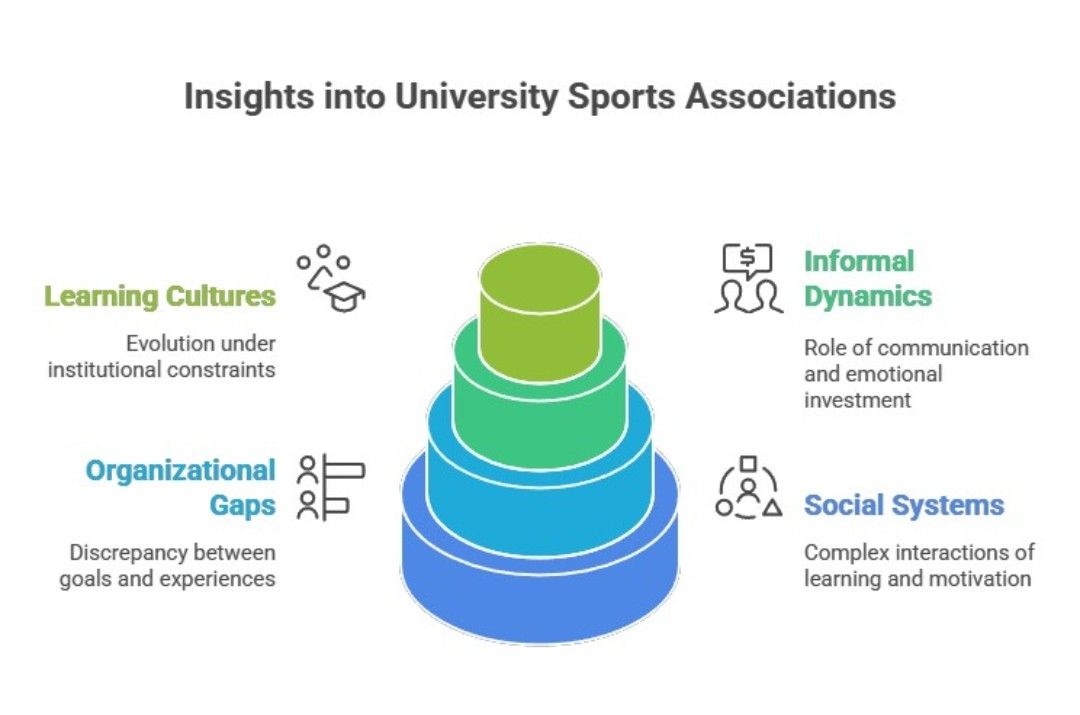Transforming University Sports Associations into Learning Organizations: A Case Study of Harbin Normal University
Main Article Content
Abstract
This study investigated how a Chinese university sports association can be transformed into a learning organization by focusing on three key dimensions: learning culture, optimized structure, and supportive environment. A mixed-methods design was employed at Harbin Normal University, involving a questionnaire survey of 134 student association members and in-depth interviews with 11 faculty advisors. Quantitative results from multiple regression analysis indicated that all three dimensions significantly predicted the perceived effectiveness of the sports association as a learning organization (R² = 0.45, F = 35.08, p < .001). Among these factors, a supportive environment emerged as the strongest predictor of successful organizational learning (β = 0.33), followed by a strong learning culture (β = 0.30) and an optimized structure (β = 0.26). Qualitative findings revealed that the sports association provided valuable opportunities for students’ leadership development, teamwork, and emotional well-being; however, it faced challenges such as limited resources, unclear organizational structures, and weak institutional backing. Based on these insights, the study proposes an integrated strategy that combines experiential learning initiatives, participatory leadership structures, and strengthened policy support. This strategy aims to guide the transformation of university sports associations into sustainable, student-centered learning environments in higher education. The findings underscore the critical role of institutional support and organizational adaptation in enhancing the educational impact of collegiate sports associations.
Article Details

This work is licensed under a Creative Commons Attribution-NonCommercial-NoDerivatives 4.0 International License.
References
Abruzzo, K. J., Lenis, C., Romero, Y. V., Maser, K. J., & Morote, E. S. (2016). Does Participation in Extracurricular Activities Impact Student Achievement?. Journal for Leadership and Instruction, 15(1), 21-26.
Arı, A., & Taşgın, E. (2023). The relationship between organizational social capital, organizational identity and organizational trust levels of academicians in sports education institutions. Turkish Journal of Sport and Exercise, 25(3), 433-445.
Casey, M. M., Eime, R. M., Harvey, J. T., Sawyer, N. A., Craike, M. J., Symons, C. M., & Payne, W. R. (2017). The influence of a Healthy Welcoming Environment on participation in club sport by adolescent girls: a longitudinal study. BMC sports science, medicine and rehabilitation, 9(1), 12.
Chelladurai, P., & Kerwin, S. (2018). Human Resource Management in Sport and Recreation. (3rd ed.). Illinois: Human Kinetics.
Edmondson, A. (1999). Psychological safety and learning behavior in work teams. Administrative science quarterly, 44(2), 350-383.
Eime, R. M., Young, J. A., Harvey, J. T., Charity, M. J., & Payne, W. R. (2013). A systematic review of the psychological and social benefits of participation in sport for children and adolescents: informing development of a conceptual model of health through sport. International journal of behavioral nutrition and physical activity, 10(1), 98.
Garvin, D. A. (1993). Building a learning organization. Harvard Business Review, 71(4), 78–91.
Kezar, A. (2005). What campuses need to know about organizational learning and the learning organization. New Directions for Higher Education, 131, 7-22.
Khasawneh, S., Abu-Alruzz, J., Alawneh, A., & Al-Jaradat, M. (2023). The impact of social capital on organisational learning in higher education: a tool for empowerment, innovation, and competitive advantage. Research in Post-Compulsory Education, 28(4), 670-692.
Lee, S., & Han, S. H. (2024). Learning organization culture and knowledge sharing: the mediating role of social capital. Journal of Workplace Learning, 36(8), 770-787.
Li, J., Wan, B., Yao, Y., Bu, T., Li, P., & Zhang, Y. (2023). Chinese path to sports modernization: fitness-for-all (Chinese) and a development model for developing countries. Sustainability, 15(5), 4203.
Lower-Hoppe, L. M., Brgoch, S., Bailey, R., Ryder, A., Lowe, C., Dahl, S., & Wray, D. (2020). How do collegiate sport clubs achieve organizational effectiveness?. Journal of Applied Sport Management, 12(2), 4.
Meng, X., Horrell, A., McMillan, P., & Chai, G. (2021). ‘Health First’ and curriculum reform in China: The experiences of physical education teachers in one city. European Physical Education Review, 27(3), 595-612.
Oliveira, T. C. D., Carneiro-da-Cunha, J. A., Colagrai, A. C., Ferreira, M. P., & Mazieri, M. R. (2024). Organizational policies as a means of sharing sports values among athletes: the role of social capital. Journal of Strategy and Management, 17(3), 444-465.
Senge, P. M. (1990). The Fifth Discipline: The Art and Practice of the Learning Organization. New York: Doubleday.
Vasold, K. L., Kosowski, L. E., & Pivarnik, J. M. (2019). Academic Success and 1 Year of Intramural Sports Participation by Freshmen Students. Journal of College Student Retention: Research, Theory & Practice, 23(2), 383-392.

